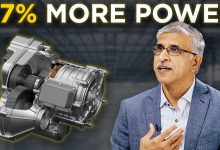It might be surprising to know that in electric trains, the power collected from the overheadlines ends up in the grounding cable of the track after flowing through the wheels. Three phase power conversion, regenerative braking and zig-zag overheadlines – all these make electric train technology quite unique. Let’s understand all the engineering secrets behind the electric trains starting from the simplest design possible.
Video Credits: https://www.youtube.com/watch?v=GJbUI2D3rLY
Disclaimer: This video is posted for educational purposes only. We do not intend to violate any copyright or intellectual property rights. All rights remain with their respective owners. If you have any concerns or issues regarding this content, please contact us Here.
Thank you for your understanding and support.










Electricity enters from the overhead wire and leaves into the ground by the wheels… But wheels are attached to the metal body of the train… Why touching the outer body does not give us the shock?
If current is going into ground through the tracks then why the entire track is not electrified? Why we dont get any shock when place our head on the tracks (to listen to the approaching train)?
Nice video … well done!
Why not use eddy current braking for emergency braking?
could have better outro but we will take it
Please change your channel name to Lesics, I'd rather have that name
Definitely I hope they invest in electric trains it will cut down on some of the natural gas & diesel fuel to make basic trains run the benefit of this kind of ingenuity is way better & smoother to import & export goods the commerce in this kind of future transportation is golden 😊
In the Brisbane system there are dead spots in the overhead because the electricity supply in different sections are not the same phase, so a magnet in the track moves a switch to cut off the power and then turns back on in the new section. I knew this because I heard a train make two sharp mechanical “clunks” under the carriage and I looked into it.
The Melbourne system is 1500VDC and does not have this problem, for years I was told that a 25KV AC system is more efficient than a DC system and now I see a disadvantage in an AC system. I think they don’t have this problem in Europe, how difficult would it be technically to synchronize the phase? If the overhead is separated by dead sections then you could only supply power to sections where a train is running whereas, on a DC system, the whole network has to be live.
I saw a documentary where bringing a power station online to synch with the grid was a tedious manual system where the frequency was moved up and down to sync, now done with computers.
The animated explanation helped me understand.
Amazing video ❤. Very informative and easy to understand.